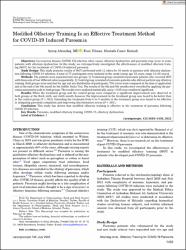| dc.contributor.author | Altundağ, Aytuğ | |
| dc.contributor.author | Yılmaz, Eren | |
| dc.contributor.author | Kesimli, Mustafa Caner | |
| dc.date.accessioned | 2023-10-18T08:05:24Z | |
| dc.date.available | 2023-10-18T08:05:24Z | |
| dc.date.issued | 2022 | en_US |
| dc.identifier.issn | 0023-852X | |
| dc.identifier.issn | 1531-4995 | |
| dc.identifier.uri | https://hdl.handle.net/11363/5936 | |
| dc.description.abstract | Objectives: Coronavirus disease (COVID-19) infection often causes olfactory dysfunction and parosmia may occur in some
patients with olfactory dysfunction. In this study, we retrospectively investigated the effectiveness of modified olfactory training (MOT) for the treatment of COVID-19-induced parosmia.
Study Design: This study presents results of MOT performed with 12 odors for 36 weeks in patients with olfactory dysfunction following COVID-19 infection. A total of 75 participants were included in the study (mean age 33 years, range 16–60 years).
Methods: The patients were separated into two groups: 1) Treatment group consisted of parosmia patients who received MOT
with three sets of four different odors sequentially. 2) Control group consisted of parosmia patients who did not perform any olfactory
training. Both groups were matched for age and sex distribution of participants. TDI scores were compared at the time of application
and at the end of the 9th month by the Sniffin’ Sticks Test. The results of the 0th and 9th months were recorded by applying the parosmia assessment scale to both groups. The results were analyzed statistically, and p < 0.05 was considered significant.
Results: When the treatment group and the control group were compared, a significant improvement was observed in
both groups at the third, sixth, and ninth month, however the improvement in the treatment group was found to be better than
in the control group (P < .001). Extending the treatment from 6 to 9 months in the treatment group was found to be effective
in mitigating parosmia complaints and improving discrimination scores (P < .001).
Conclusion: This study has shown that modified olfactory training is effective in the treatment of parosmia following
COVID-19 infection. | en_US |
| dc.language.iso | eng | en_US |
| dc.publisher | WILEY, 111 RIVER ST, HOBOKEN 07030-5774, NJ | en_US |
| dc.relation.isversionof | 10.1002/lary.30101 | en_US |
| dc.rights | info:eu-repo/semantics/openAccess | en_US |
| dc.rights | Attribution-NonCommercial-NoDerivs 3.0 United States | * |
| dc.rights.uri | http://creativecommons.org/licenses/by-nc-nd/3.0/us/ | * |
| dc.subject | Parosmia | en_US |
| dc.subject | modified olfactory training | en_US |
| dc.subject | COVID-19 | en_US |
| dc.subject | olfactory dysfunction | en_US |
| dc.title | Modified Olfactory Training Is an Effective Treatment Method for COVID-19 Induced Parosmia | en_US |
| dc.type | article | en_US |
| dc.relation.ispartof | The Laryngoscope | en_US |
| dc.department | Sağlık Bilimleri Fakültesi | en_US |
| dc.authorid | https://orcid.org/0000-0003-0794-5050 | en_US |
| dc.identifier.volume | 132 | en_US |
| dc.identifier.issue | 7 | en_US |
| dc.identifier.startpage | 1433 | en_US |
| dc.identifier.endpage | 1438 | en_US |
| dc.relation.publicationcategory | Makale - Uluslararası Hakemli Dergi - Kurum Öğretim Elemanı | en_US |
| dc.institutionauthor | Yılmaz, Eren | |



















